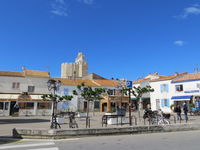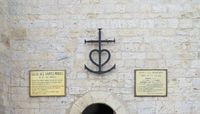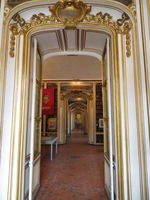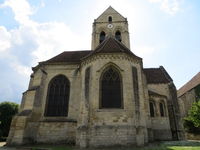A Library Tourist
By Bianca Lakoseljac
By Bianca Lakoseljac: OB Writer in Residence
As a child growing up in a small village in the countryside near Belgrade in the former Yugoslavia, I had three problems: first was not having many friends; the second—my school did not have a library; and the third—I lived on the far side of the village, away from the centre where the “action” was: the variety store, the community centre where school performances were held and the local youth group showed movies once a week, and the soccer field where Sunday afternoon games provided entertainment. But the tiny village library was an easy walk from my home. And it was the village library that solved my problems. I spent so much time there, the librarian whom I first thought of as a grumpy old man (in his forties—I was about nine) became my best friend, and the books—with all the happy, sad, scary, adventures stories—my refuge. The library became my second home.
Later on as a teacher, I could always recognize readers by their broad knowledge. And I’ve always felt this subconscious connection with readers. As a writer, more than ever, I feel that librarians are my best friends. We always have one thing in common—the love of books. When I am in a new town, I look for the library. As soon as I walk into the local library, I am home.
I am, in a way, a library tourist.
During my travels, I usually donate a copy of my latest book to the local library. This gives me a sense of belonging, of being part of the place and, in a way, of its culture. In the spring of 2012, shortly after my novel, Summer of the Dancing Bear, was published, I visited France. The novel, which explores the gypsy culture and is set in the former Yugoslavia in the countryside near Belgrade where I lived as a child, also links events from various parts of Europe where gypsies travel, France being one of the main gathering places.
As part of my research for a sequel, I visited Les Saintes-Maries-de-la-Mer (“Three Marys of the Sea”) in Camargue, Provence, where an annual gypsy festival takes place. In France, gypsy clans are seen as communities where ancient cultures are preserved and need to be supported. They are given special permission to hold festivals throughout the country. Les Saintes-Maries-de-la-Mer is home to an ancient fortified Romanesque church and Saint Sara’s crypt where festivals are held twice a year, in spring and fall, and to where gypsy clans from different parts of the world travel to take part. The festival culminates in a procession of clan leaders riding on horsebacks accompanying the effigy of Saint Sara—seen as the gypsy saint “who knows the woman’s heart”—to the seashore where the ritual of placing the effigy’s feet in the water symbolizes the girl-Sara’s act of bravery at sea.
There are many versions to the legend of Saint Sara and the three Marys. It was believed that Saint Sara was a gypsy girl who helped save the three Marys—Mary Magdalene, Mary Salome, and Mary Jacobe, thought to be the first witnesses to the empty tomb after the resurrection of Jesus. After the crucifixion, the Marys were believed to have set sail from Alexandria, Egypt, and their boat was caught in a storm. Sara (who was their servant-girl) used her gypsy magic and spread out her multilayered flowing skirts that turned into sails and caught the wind—and this way guided the boat safely to shore at what is now known as Saintes-Maries-de-la-Mer.
Another story has it that Sara was a gypsy girl who welcomed the Marys when they arrived on shore. She pleaded with the villagers to accept the women and to share the meager provisions with them—and so the custom of sharing one’s belongings with others less fortunate became an important part of gypsy culture. In Summer of the Dancing Bear, my character Lorca guides the protagonist Kata in the ways of the gypsies: “One of my [Lorca’s] cousins stuffed a cookie in his pocket, crumbs and all. Just how my people are. Everything’s shared.” p. 136.
Photo: Les Saintes-Maries-de-la-Mer town square with a library that holds much information on the Roma culture. The tower of the church that holds Saint Sarah's crypt is in the background.
Your CanLit News
Subscribe to Open Book’s newsletter to get local book events, literary content, writing tips, and more in your inbox
Photo: The Camargue Cross is the emblem of the church of Les Saintes-Maries-de-la-Mer (the tower seen in the above photo). It is composed of an anchor, a cross, and a heart. The upper cross is believed to represent a trident-shaped tool used by Gardiens. The anchor symbolizes the fishermen of the region. The Camargue Cross stands for three cardinal virtues: faith, hope, and charity.
During the trip, I also visited Versailles, and after touring the palace, the first place I looked for was the Municipal Library of Versailles. I found the entrance walking distance from the palace, a large double door with blue peeling paint. Founded in the seventeen hundreds and housing thousands of books from the period, this was the place where the treaty establishing American Independence was signed. The library has been building its collection of books, and I was thrilled to leave a copy of Summer of the Dancing Bear at a place with so much history. A couple of months later, receiving a thank you letter in the mail from the Library of Versailles was certainly one of the highlights of my library tourism in France.
Photo: Versailles Municipal Library Plaque.
Photo: Versailles Municipal Library entrances--each door opens up to a gallery of books.
Photo: Versailles Municipal Library books dating back to the seventeen hundreds.
During my visit to Arles, I toured the places Vincent van Gogh painted in Provence. This was a continuation of the tour that began in Holland at the Van Gogh museum, a few years earlier. At that time, I also visited Nuenen, the setting for his “The Potato Eaters,” as well as some of the windmills he painted. This library in Arles is situated in the courtyard which during Van Gogh’s time housed a hospital/sanatorium where the painter stayed for a while.
Photo: Arles Library located in the courtyard which held a hospital/sanatorium where Van Gogh stayed for a time.
In Summer of the Dancing Bear, eight year old Kata’s visit to the Van Gogh exhibit and an encounter with his paintings of wheat fields and irises transforms her view of the world she lives in: "The exhibit surfaced in her [Kata’s] memory. She, face to face with Van Gogh’s masterpieces, heart pounding, hot air rising in her throat. Her classmates pushed and played silly games obstructing her view, oblivious to her need to bask in the vibrant colours and the frenzied curves and the warmth of the swirling sun and the swaying wheat. She needed to immerse herself in the landscapes blazing under the summer heat penetrating her vision, her whole being.
Back home, she had gone to the well-thumbed picture book of Dutch painters Grandma had given her. Gazing into the paintings, she had realized she was a new person. For her, blossoming orchards, sunflowers, irises, wheat fields, the sunshine, the clouds, the well-trod path leading to her friend Maja’s house would never be the same. Van Gogh’s icy-blue stare had pierced her own vision and opened a breach through which all life took on a new meaning. All things, animate, inanimate or human, were infused with new light and shadow and with a swirl of a brush stroke were instilled with a mystical power…” p 10-11.
Auvers-sur-Oise about 30 km North-West of Paris is the town surrounded by the wheat fields Van Gogh pointed, such as the "Wheatfield with a Reaper. It also the place of his death and burial.
Photo: Auvers-sur-Oise--the Museum Library that houses many of Van Gogh's letters to his brother Theo. It also houses a number of books and other correspondence about the painter’s life.
Photo: Church in Auvers-sur-Oise painted by Van Gogh--also contains material on Van Gogh.
These are some of the highlights of my journey as a library tourist in France. It seems fitting that I should end this article with a photo of the National Library of France.
Photo: The National Library of France, in Paris.
Libraries hold a special place for readers and writers alike. For me, libraries have always been places of discovery and adventure, for I never know where that next book, or that lecture, or the history imbedded in the very foundation of the building or the town might lead me.
.................................
The views expressed in the Writer-in-Residence blogs are those held by the authors and do not necessarily reflect the views of Open Book.
Bianca Lakoseljac second novel, Stone Woman, which relives Toronto’s 1967 “summer of love”, has just been released by Guernica Editions. Bianca is the author of a novel, Summer of the Dancing Bear; a collection of stories, Bridge in the Rain (Guernica, 2012, 2010); and a book of poetry, Memoirs of a Praying Mantis (Turtle Moons Press, 2009). She is TWUC liaison for the National Reading Campaign, past president of the Canadian Authors Association, Toronto, has judged various national literary competitions, and has served on a number of literary contest panels. Bianca taught at Ryerson University and Humber College.
You can write to Bianca throughout the month of November at writer@open-book.ca.











